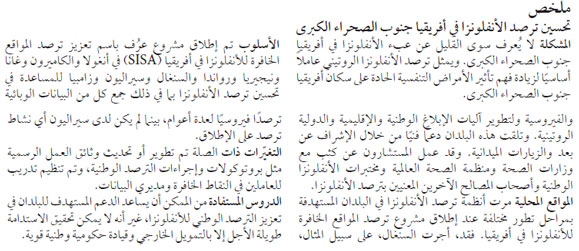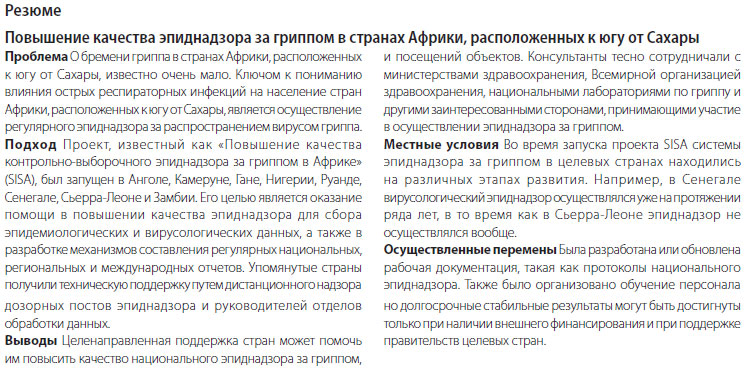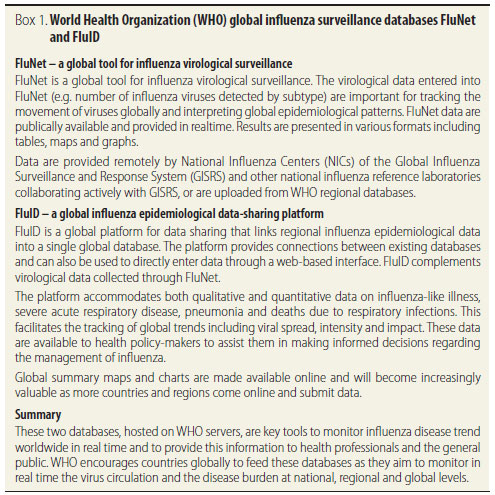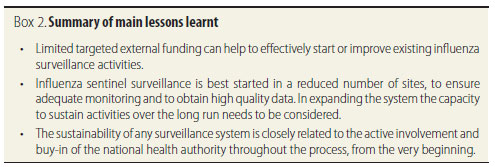LESSONS FROM THE FIELD
Improving influenza surveillance in sub-Saharan Africa
Amélioration de la surveillance de la grippe en Afrique sub-saharienne
Mejorar la vigilancia de la gripe en el África subsahariana
C SteffenI,*; F DebellutI; BD GessnerI; FC KasoloII; AA YahayaII; N AyebazibweIII; O BassongIV; Y CardosoV; S KebedeVI; S ManoncourtVII; KA VandemaeleVIII; AW MountsVIII
IAgence de Médecine Préventive, 25-28 rue du Dr Roux 75724, Paris cedex 15, France
IIDisease Surveillance and Response Programme, World Health Organization Regional Office for Africa, Brazzaville, Congo
IIIAfrican Field Epidemiology Network, Kampala, Uganda
IVYaoundé, Cameroon
VLuanda, Angola
VIAtlanta, United States of America
VIIParis, France
VIIIGlobal Influenza Programme, World Health Organization, Geneva, Switzerland
ABSTRACT
PROBLEM: Little is known about the burden of influenza in sub-Saharan Africa. Routine influenza surveillance is key to getting a better understanding of the impact of acute respiratory infections on sub-Saharan African populations.
APPROACH: A project known as Strengthening Influenza Sentinel Surveillance in Africa (SISA) was launched in Angola, Cameroon, Ghana, Nigeria, Rwanda, Senegal, Sierra Leone and Zambia to help improve influenza sentinel surveillance, including both epidemiological and virological data collection, and to develop routine national, regional and international reporting mechanisms. These countries received technical support through remote supervision and onsite visits. Consultants worked closely with health ministries, the World Health Organization, national influenza laboratories and other stakeholders involved in influenza surveillance
LOCAL SETTING: Influenza surveillance systems in the target countries were in different stages of development when SISA was launched. Senegal, for instance, had conducted virological surveillance for years, whereas Sierra Leone had no surveillance activity at all.
RELEVANT CHANGES: Working documents such as national surveillance protocols and procedures were developed or updated and training for sentinel site staff and data managers was organized.
LESSONS LEARNT: Targeted support to countries can help them strengthen national influenza surveillance, but long-term sustainability can only be achieved with external funding and strong national government leadership.
RÉSUMÉ
PROBLÈME: On sait peu de chose des conséquences de la grippe en Afrique sub-saharienne. Une surveillance régulière de la grippe est la clé d'une meilleure compréhension de l'impact des infections respiratoires aiguës sur les populations d'Afrique sub-saharienne.
APPROCHE: Un projet connu sous le nom de Renforcement de la surveillance sentinelle de la grippe en Afrique (SISA) a été lancé en Angola, au Cameroun, au Ghana, au Nigeria, au Rwanda, au Sénégal, en Sierra Leone et en Zambie pour aider à améliorer la surveillance sentinelle de la grippe, y compris la collecte des données épidémiologiques et virologiques, et développer des mécanismes réguliers de rapports nationaux, régionaux et internationaux. Ces pays ont reçu un appui technique combinant une supervision à distance et des visites sur place. Des consultants ont travaillé en étroite collaboration avec les ministères de la santé, l'Organisation mondiale de la Santé, les laboratoires nationaux de la grippe et d'autres intervenants impliqués dans la surveillance de la grippe.
ENVIRONNEMENT LOCAL: Les systèmes de surveillance de la grippe dans les pays cibles étaient à différents stades de développement quand SISA a été lancé. Le Sénégal, par exemple, effectuait une surveillance virologique depuis des années, tandis que la Sierra Leone n'avait aucune activité de surveillance.
CHANGEMENTS SIGNIFICATIFS: Des documents de travail tels que des procédures et des protocoles nationaux de surveillance ont été élaborés ou mis à jour, et la formation du personnel de site sentinelle et des gestionnaires de données a été organisée.
LEÇONS TIRÉES: Un appui ciblé aux pays peut les aider à renforcer la surveillance nationale de la grippe mais la viabilité à long terme n'est possible qu'avec un financement externe et un solide leadership du gouvernement national.
RESUMEN
SITUACIÓN: Existe poca información sobre la carga de morbilidad de la gripe en el África subsahariana. La vigilancia rutinaria de la gripe es clave para poder entender mejor el impacto de las infecciones respiratorias agudas en las poblaciones del África subsahariana.
ENFOQUE: Se inició un proyecto conocido como SISA, Strengtheninginfluenza sentinel surveillance in Africa, (Refuerzo de la vigilancia centinela de la gripe en África) en Angola, Camerún, Ghana, Nigeria, Ruanda, Senegal, Sierra Leona y Zambia para ayudar a mejorar la vigilancia centinela de la gripe, incluida la recopilación de datos epidemiológicos y virológicos, y para desarrollar mecanismos de información rutinarios a nivel nacional, regional e internacional. Estos países recibieron asistencia técnica por medio de supervisión remota y visitas directas. Los consultores trabajaron estrechamente con los ministerios de sanidad, la Organización Mundial de la Salud, los laboratorios nacionales de gripe y otros interesados relacionados con la vigilancia de la gripe.
MARCO REGIONAL: Los sistemas de vigilancia de la gripe en los países objetivo se encontraban en diferentes fases de desarrollo cuando se implementó el proyecto SISA. Por ejemplo, en Senegal se había llevado a cabo la vigilancia virológica durante años, mientras que en Sierra Leona no se había realizado ninguna actividad de vigilancia.
CAMBIOS IMPORTANTES: Se desarrollaron o actualizaron los documentos de trabajo, como protocolos y procedimientos de vigilancia nacional, y se organizaron cursos para el personal centinela in situ y para los administradores de datos.
LECCIONES APRENDIDAS: La asistencia específica para los países puede ayudar a los mismos a reforzar la vigilancia de la gripe a nivel nacional, pero solo se puede conseguir una sostenibilidad a largo plazo con financiación externa y con un fuerte liderazgo gubernamental nacional.



Introduction
Acute respiratory infections are major contributors to morbidity and mortality in Africa,1 yet the burden of influenza in African countries is still poorly understood.2, 3 In the Afriflu meeting that was held in June 2010 in Marrakesh, Morocco, influenza specialists and public health experts pledged to follow concrete measures to bridge the knowledge gap on the burden of influenza in Africa.4 One of the key measures recommended was the reinforcement of routine influenza surveillance capacity both from an epidemiological and a virological standpoint. Surveillance data from the African continent has increased substantially in the past five years, but they are still too sparse and inconsistent to allow for a thorough understanding of influenza virus circulation patterns on the continent and their associated morbidity and mortality, or to inform influenza control strategies.
Generating robust seasonal influenza surveillance data is a concern both regionally and globally. The 2009 influenza pandemic had highlighted the importance of using a standardized approach and terminology in conducting influenza surveillance activities. In March 2011, the World Health Organization (WHO) held an expert consultation in Geneva, Switzerland, to develop global standards for influenza surveillance.5 The specific aims of the meeting were to update case definitions for influenza-like illness (ILI) and severe acute respiratory infection (SARI) and to provide guidance on creating and maintaining influenza sentinel surveillance systems.
To improve regional capacity for surveillance, WHO's Regional Office for Africa developed a regional strategy whereby ILI and SARI were included as priority diseases in the technical guidelines for integrated disease surveillance and response in the African Region,6 as well as in specific guidelines for influenza sentinel surveillance. WHO selected eight target countries in sub-Saharan Africa - Angola, Cameroon, Ghana, Nigeria, Rwanda, Senegal, Sierra Leone and Zambia - to receive support in starting or strengthening influenza sentinel surveillance and in improving data sharing nationally, regionally and globally via WHO's FluNet and FluID databases ( Box 1 ).7, 8 This endeavour, known as the Strengthening Influenza Sentinel Surveillance in Africa (SISA) project, was implemented by the Agence de Médecine Préventive in close collaboration with WHO.

Project objectives and methods
The primary objective of the SISA project was to develop or strengthen influenza sentinel surveillance systems in line with WHO standards in selected sub-Saharan African countries. Countries were chosen in a way intended to synergistically enhance the surveillance capacity development activities being supported in the region by other organizations. The ultimate goal was to generate a representative network of functional surveillance systems that would provide a reasonably accurate picture of influenza activity on the African continent. Countries were given support in the development of routine influenza data collection, analysis and reporting mechanisms at the national and international level, the latter via global databases.
During the field implementation of the project, three epidemiologists were deployed to the capitals of Angola, Cameroon and Sierra Leone to assist in the organizational, technical and managerial aspects of strengthening influenza surveillance and to provide support in developing influenza sentinel surveillance protocols and operating procedures. Five additional countries - Ghana, Nigeria, Rwanda, Senegal and Zambia - received technical support through remote supervision and onsite visits by two other epidemiologists. Consultants worked in close collaboration with health ministries, WHO, national influenza laboratories and other partners involved in influenza surveillance (such as the United States Centers for Disease Control and Prevention [CDC] in Atlanta, United States Naval Medical Research Unit No.3 [NAMRU-3] in Cairo, and the Institut Pasteur International Network, headquartered in Paris).
The first step of the project was to assess ongoing influenza activities, identify shortcomings and challenges, and recommend improvements with regard to epidemiological and virological data collection, analysis, reporting and sharing. Subsequently, the work focused on providing technical support to surveillance staff in sentinel sites and in the health ministries in implementing the recommended improvements through the development of country-specific protocols and standard operating procedures.
Results
The SISA project targeted countries whose influenza surveillance systems were in different stages of development. For example, when the project started, Sierra Leone had no influenza surveillance activity, whereas Senegal had a long history of virological surveillance. The project had to adapt to different country contexts and find the most appropriate ways to support existing partners and strengthen surveillance systems. Much of the activity focused on developing or supporting the epidemiological component of surveillance, which was generally identified as the weakest element of the existing systems. In-country support to influenza surveillance activities lasted approximately eight months, from May to December 2011.
Practical protocols and operating procedures were developed to obtain a core set of epidemiological surveillance data of good quality despite the limited human and financial resources. Emphasis also was placed on discussing with national partners the usefulness of sharing influenza surveillance data with the international community via WHO's global influenza surveillance databases. Training on the use of these databases was provided to data managers in health ministries, to national public health laboratories and to other relevant partners.
The case definitions used for ILI and SARI followed - with some minor country variations - the ones given in WHO's regional guidelines.4
Several valuable lessons emerged from implementing the SISA project ( Box 2 ). The active involvement of the health authorities in the SISA project was one of the key elements in its success. From the beginning of the project, responsibility for sustainably improving the functioning of the surveillance system remained with health ministry staff, who built on existing national surveillance mechanisms. Public health professionals showed keen interest in obtaining an accurate estimate of the health impact of influenza, especially within the overall burden of respiratory disease.

The approaches used to improve influenza surveillance varied between countries. In general, SISA worked through a step-by-step process, with initial efforts focused on a small number of sentinel sites. The purpose of this was to obtain a core set of high-quality data rather than to try to immediately implement a multi-site, comprehensive national system that would be difficult to support and to routinely supervise. Nevertheless, some countries, in keeping with SISA's country-driven approach, chose to implement surveillance in a larger number of sites.
Many target countries were receiving external support from international partners, including the CDC, NAMRU-3, the US Department of Health and Human Services and the Institut Pasteur International Network or independent Institut Pasteur laboratories. Assistance focused on technical and financial support for virological specimen and data collection. Since substantial laboratory activities existed at the start of the SISA project, a key SISA objective was to enlist the support of virology laboratory staff for improving epidemiological surveillance.
In some countries data collection proved more difficult or time-consuming than anticipated. This was especially true for age-specific counts of ILI and SARI cases using WHO case definitions and for counts of total consultations/hospitalizations (necessary to estimate incidence and temporal trends). A key SISA activity was to assist countries in developing processes to minimize the extra workload required of site personnel and thus improve the likelihood of project sustainability.
Despite these challenges, the project yielded tangible results. Epidemiological influenza data collection started in all of the target countries. The results obtained in Sierra Leone are given in Box 3 by way of an example.

Conclusion
The establishment and strengthening of national surveillance capacity supports the long-term goal of generating improved data for national decision-making. While much work remains to be done, SISA achieved many of its objectives in connection with improved influenza surveillance. Data collection began where none existed; national influenza plans were developed, and countries were re-oriented towards a vision of more accurate and limited data collection, privileging data quality over quantity. Additionally, the project catalysed national interest in influenza and more generally in respiratory disease surveillance and in implementing more rigorous surveillance methods. Overall, SISA has demonstrated that targeted external field support can successfully help countries to start new influenza surveillance systems or reinvigorate existing ones.
SISA's sustainability will depend on several factors. In the short term additional external funding will probably be needed to sustain gains and further improve influenza surveillance systems. The long-term sustainability of externally-funded national influenza surveillance in Africa will depend on convincing health authorities of the usefulness of surveillance data for national and regional preventive and clinical management programmes, national economic growth, and successful intervention for other pressing health care priorities. 
Acknowledgements
The field implementation of the project was made possible by the active contribution of staff in sentinel sites, national influenza laboratories, national public health laboratories, ministries of health and WHO country offices.
References
1. Yazdanbakhsh M, Kremsner PG. Influenza in Africa. PLoS Med 2009;6:e1000182. doi: 10.1371/journal.pmed.1000182 PMID: 20016686
2. Nair H, Brooks WA, Katz M, Roca A, Berkley JA, Madhi SA et al. Global burden of respiratory infections due to seasonal influenza in young children: a systematic review and meta-analysis. Lancet 2011;378:1917-30. doi: 10.1016/S0140-6736(11)61051-9 PMID: 22078723
3. Gessner BD, Shindo N, Briand S. Seasonal influenza epidemiology in sub-Saharan Africa: a systematic review. Lancet Infect Dis 2011;11:223-35. doi: 10.1016/S1473-3099(11)70008-1 PMID: 21371656
4. Steffen C, Diop OM, Gessner BD, Hacen MM, Hassar M, Katz MA et al. Afriflu - international conference on influenza disease burden in Africa, 1-2 June 2010, Marrakech, Morocco. Vaccine 2011;29:363-9. doi: 10.1016/j. vaccine.2010.11.029 PMID: 21111779
5. WHO global technical consultation: global standards and tools for influenza surveillance. Geneva: World Health Organization; 2011. Available from: http://whqlibdoc.who.int/hq/2011/WHO_HSE_GIP_2011.1_eng.pdf [accessed 3 February 2012] .
6. Technical guidelines for integrated disease surveillance and response in the African Region [Internet]. Geneva: World Health Organization; 2012. Available from: http://www.afro.who.int/en/clusters-a-programmes/dpc/integrated-disease-surveillance/features/2775-technical-guidelines-for-integrated-disease-surveillance-and-response-in-the-african-region.html [accessed 3 February 2012] .
7. FluNet [Internet]. Geneva: World Health Organization; 2012. Available from: http://www.who.int/influenza/gisrs_laboratory/flunet/en/ [accessed 3 February 2012] .
8. FluID - a global influenza epidemiological data sharing platform [Internet]. Geneva: World Health Organization; 2012. Available from: http://www.who.int/influenza/surveillance_monitoring/fluid/en/index.html [accessed 3 February 2012] .
Submitted: 26 October 2011
Revised version received: 24 January 2012
Accepted: 30 January 2012
Funding: The SISA project was funded through a grant from WHO.
Competing interests: S Steffen, F Debellut and BD Gessner work for Agence de Médecine Préventive, which receives unrestricted funding from Sanofi Pasteur and grant-specific support from Sanofi Pasteur, Pfizer, Merck and GlaxoSmithKline. However, the current study was funded entirely through a grant from the World Health Organization.
* Correspondence to: C Steffen (e-mail: csteffen@aamp.org).
